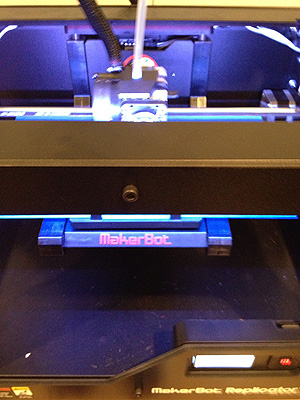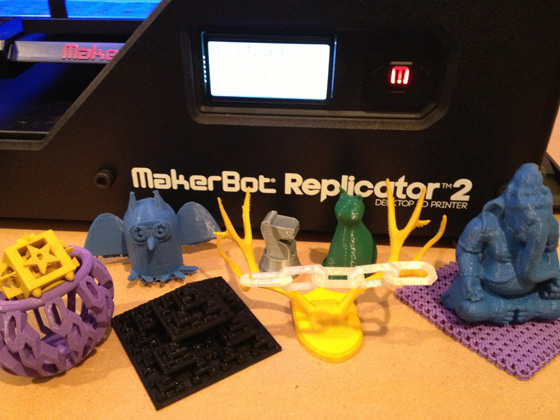| « Positive Babel Mural Celebrates Old Irving Park, a City Melting Pot | "Where's home, Dr. Stone?" "Lake Zurich, Illinois." » |
Technology Tue Sep 03 2013
Science Fiction Comes to Life in a Public Library
These days, by using a digital model, you can make a solid object. The implications are enormous and with genie out of the bottle, a new world awaits the possibilities that are bound to be wonderful or misused depending on the motivation of the creator. So when the Harold Washington Library announced the opening of a Maker Innovation Labs featuring 3D printers, my interest was piqued and I knew I had to go.
The interactive exhibit runs through the end of the year, with workshops being held to familiarize participants with the design software, allowing you to create and then print items such as key chains and desk organizers.
 The process begins by creating a computer file similar to architects' CAD drawing programs (computer aided design), in which three-dimensional objects are formed by drawing planes and using a push-and-pull tool that imparts depth to the design. It's then loaded into "slicing" software that in turn breaks it down into 1-3mm cross-section slices (similar to how an MRI works) and makes a digital model.
The process begins by creating a computer file similar to architects' CAD drawing programs (computer aided design), in which three-dimensional objects are formed by drawing planes and using a push-and-pull tool that imparts depth to the design. It's then loaded into "slicing" software that in turn breaks it down into 1-3mm cross-section slices (similar to how an MRI works) and makes a digital model.
Saving the file to a memory card (like you would with your camera), you insert that into the 3D Makerbot replicator printer. The printer then uses whatever medium it's designed for (plastic, nylon, cookie dough, stem cells) and, moving in three axes (X + Y are horizontal layers, Z is the height /vertical layer), it creates the 3D object from the program. In the case of plastic it's then heated to 200-240 degrees Celsius and extruded accordingly. If using a powder-based resin, a laser fuses light-sensitive liquids into the final form.
It's interesting to note that with this type of design, complexity is free; it's mass that makes up the primary time spent, and its cost. By doubling the size of an object, the time taken to print triples.
The exhibition has spawned an artist in residency program. In conjunction with Chicago Artists Month artist/educator Tom Burtonwood will spend his residency working on a 3D printed book of architectural ornaments and reliefs from the Chicago area. Burtonwood is working with Chicago cultural historian Tim Samuelson to produce this publication with the goal of archiving and distributing digital copies of Chicago's rich architectural legacy. Each page of the book will feature an individual architectural detail rendered in three dimensions, or as Burtonwood likes to say, "liberating images into textures."
Burtonwood will also lead workshops demonstrating the scanning software and encourage members of the public to contribute content. Pages from the book will then be printed at the Innovation Lab with copies of the finished publication posted to the online file repository Thingiverse, where anybody can download the 3D book and make it on a 3D printer.
Like many new technologies, though, at the moment 3D printing costs are prohibitive to many. But one only needs to remember the price of a laptop or DVD player when they first came out to know that with time prices will drop.
Manufacturing is often a process of subtracting smaller pieces from larger via cutting or drilling. Sculpting if you will -- or as Michelangelo said, "I see the angel in the marble and carved until I set him free."

3D printing is instead additive in nature. Building layer upon layer is more efficient and means less waste with the end result in turn being cheaper or sturdier. Take for instance, seams. What if you could design a piece of heavy machinery with no welds to weaken its structure? One would only need a printer large enough to print it. NASA recently tested 3D printed rocket injectors that, when put through their paces, excelled beyond expectations.
An artificial jaw and ear have already been printed out of cultured tissue, with incredible results, and a kidney is in the works. What if a 3D printer using living cells could regenerate a liver and solve the shortage of transplantable organs without needing a donor? Beyond biotech medicine there are practical applications in fashion, architecture, industrial design... really in just about anything you can dream of.
Then there's the fact that these items are built on demand, eliminating the need for warehousing and keeping costly inventory. The supply chain as we know it, no longer needed. It could also allow people in remote areas to possibly produce their own medicine or homes at a fraction of the cost.
A machine that can replicate itself?
The US Army's Space and Missile Defense Command has developed a backpack-sized 3D printer that can make spare parts behind the front line. They love its inherent ability to quickly prototype spare parts like sensor housings and casings. D Shannon Berry, an operations research analyst at the Future Warfare office, said, "The ability to replicate parts quickly and cheaply is a huge benefit to the warfighter. Instead of needing a massive manufacturing logistics chain, a device that generates replacement parts is now small and light enough to be easily carried in a backpack or on a truck. The device can even be used to fix itself if it breaks as many of its parts are built to be duplicable by 3D printers."
Speaking of NASA, Chicago's "Willie Wonka of Gastronomy" futurist chef Homaro Cantu was brought on board to try to reproduce food for a manned Mars spaceflight. While manipulating food for NASA's ready-to-eat meals, funding issues ended the project prematurely, but in conversation Cantu told me that he feels "it's easier to pick an apple than try to replicate one," and that it probably won't happen in his lifetime.
Cantu also has experimented with building a polymer cooking box whose prototype was developed with a 3D printer. Placed in a microwave for a short period of time, it has the ability to retain heat for hours while remaining cool to the touch. In fact, he cooks fish at the table in them at his Fulton Market restaurant Moto.
What about intellectual property? How will that be handled in our brave new world where you could make an Oscar or a Stanley Cup or a pair of Levis? Guaranteed the powers that be are not going to like that very much.
Cantu suggested watching a movie about the true story of the future: The Singularity Is Near. He told me, "We live in a new world where technology is exponentially increasing information and this movie sums it up really well."
With its potential to be used for good or evil, though, how it plays out will be judged on a case-by-case basis. Earlier this year, 3D printing broke into the national consciousness when plans for a gun called "the Liberator" were released, much to the horror (or thrill) of many. Made of plastic, the only metal parts needed were the firing pin and the bullets. In all, over 100,000 copies of the plans were downloaded before the government put an end to it.
But as the internet is forever, the damage is done.
With a groundswell of crafters, artisans, scientists and engineers supporting a vibrant maker culture worldwide, these do-it-yourself community operated workplaces are becoming more and more common. By bringing it to the people, with wonder wheels turning and creativity stimulated, ideas advance at a Renaissance like rate.
When I asked the librarians what the most memorable moments to come out of this installation have been, two instances were quickly mentioned: some med students who created a stem cell model, and the science teacher who drove from Michigan with son in tow, who after a few attempts designed a lightning bolt to be affixed to the spokes of his bicycle.
Truly a revolution is afoot, and while change is most certainly in the air, in exchange for great benefits, I can't help but feel that we're opening the doors to great possible dangers as well.
CPL Innovation Lab
Harold Washington Library
400 S. State, 3rd flr.
312-747-4300
Hours
Monday through Thursday: 10am to 8pm
Friday and Saturday: 10am to 4pm
Sunday: 2pm to 4pm
About the Author
Alan Lake has been a professional chef for three decades and has won numerous awards, professional competitions and distinctions. He's mainly writing now and hoping to publish his book Garlic Manifesto, the history of garlic thru the ages. He's also been a professional musician most of his life and coined the term "Jazzfood" to describe his cuisine as "solid technique based upon tasteful improvisation" and views his food as he does his music.








